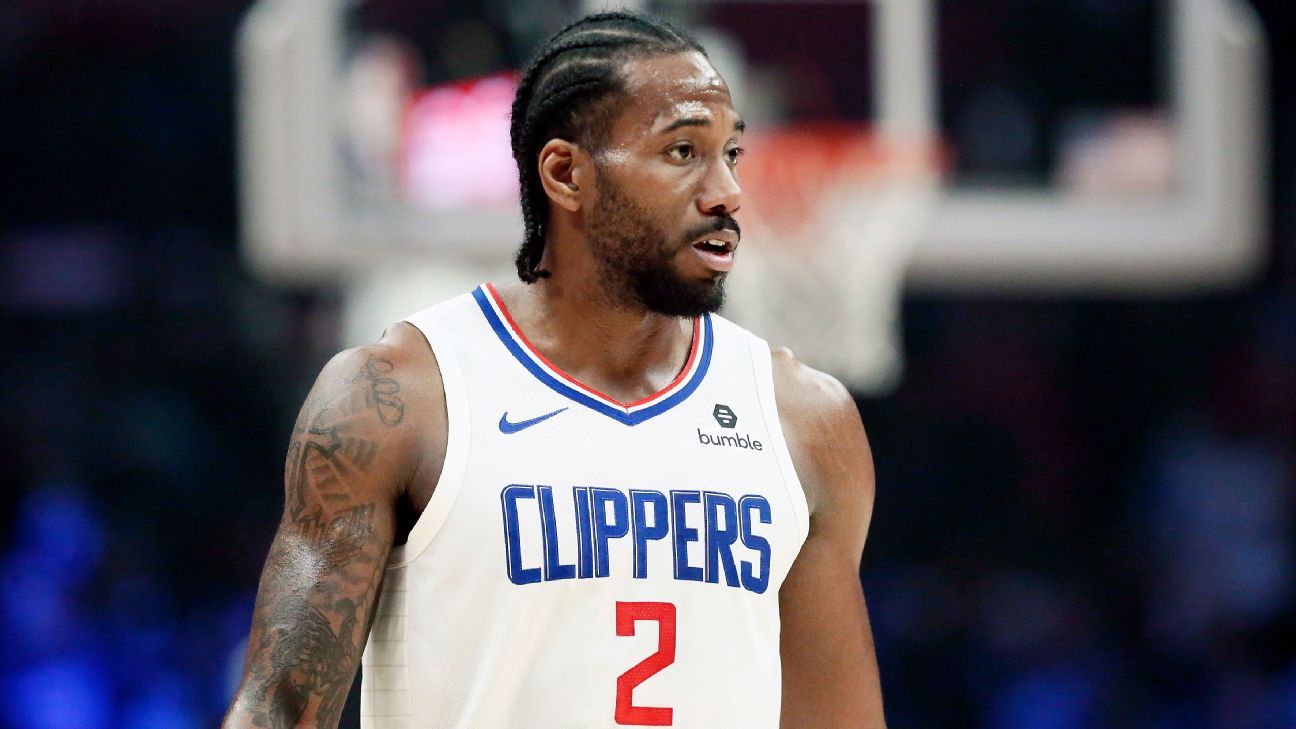Ten years ago, only cutting-edge sports scientists knew the term load management. Today, it is sparking a popular revolt that hit new heights last week when LA Clippers forward Kawhi Leonard sat out a nationally televised game at Utah on the first night of a back-to-back.
This was nothing new: Leonard, who missed most of the 2017-18 season because of tendinopathy in his right quad, hasn’t played in both ends of a back-to-back since April 2017. His load management program last season with the Toronto Raptors, in which he played in only 60 regular-season games, helped propel his team to its first NBA championship, and Leonard took home the NBA Finals MVP trophy.
Leonard didn’t invent the modern NBA load management regimen, but he might have perfected it — and he has certainly popularized it. Whether it’s Memphis Grizzlies rookie Ja Morant or Dallas Mavericks big man Kristaps Porzingis, more players from more teams than ever are watching regular-season games in street clothes while some old-school critics seethe in disgust. These opponents of load management bemoan an NBA that has gone soft, permitting athletes making tens of millions of dollars with no apparent injuries to sit out games that hard-working fans paid good money to attend.
Load management is among the most debated, least understood issues in the NBA today. It isn’t just an indiscriminate, excused absence from a regular-season game. It’s a program that seeks to have a team’s most important contributors playing at optimal health in the biggest moments for many years.
In a real sense, the friction between believers and skeptics exists because the best science (the density of the NBA schedule elevates injury risk) has come into conflict with NBA folklore (championships are the pinnacle of success). Given the speed and athleticism deployed in today’s game, it’s becoming increasingly difficult for players to remain consistently healthy. A good bill of health is a prerequisite for team glory, which can make load management vital.
Leonard will likely sit out another regular-season game Thursday, when the Clippers travel to New Orleans to face the Pelicans. Here’s our best intelligence as to why:
What does load management even mean?
Load management is a program employed by NBA teams and players to monitor the physiological stress (or load) a player endures doing any number of activities.
Minutes played in live games is just one of many elements measured when examining a player’s load relative to his capacity. A player exerts himself during practices, individual skill sessions, cardio work, dynamic warm-up routines, postgame recovery regimens, cross-country flights, lack of sleep, you name it. All of this info is fed into the load management program, and a group consisting of the player, training staff, sports scientists, coaches, management and, often, ownership collaborate to look at the biometric data and determine when that player is bumping up against his load capacity.
“Loading management is about lowering the threshold of load on a player so that he’s able to recover and decrease the risk of injury or chronic fatigue,” said Dr. Marcus Elliott, founder and director of the Peak Performance Project.
When a player exceeds his capacity, he’s considerably more likely to get injured. Load management is a provision to say of a player suffering from, say, patella tendinitis, “He’s healthy, and he can play … but if he exerts himself too much, there’s a chance he’ll then miss significant time.”
All of this is done with one overriding goal: Make sure the player is healthiest and at peak fitness when the games matter most.
What’s the history here, and what has changed over time?
While we can trace the origins of load management back many years, the term itself seemed to originate in the NBA with the Philadelphia 76ers sitting out Joel Embiid in 2017-18 after he missed his first two seasons due to navicular fractures and much of his rookie campaign due to a knee injury that eventually required arthroscopic surgery. Not coincidentally, this came after the NBA implemented rules regarding “rest” games in September 2017. The league treats management of a specific injury differently than rest, though a memo sent to teams by NBA president of league operation Byron Spruell earlier this week (per Jeff Zillgitt of USA Today) clarified that teams should not use the phrase to report the injury.
Although other teams had followed the Sixers’ lead in citing load management by that point, it exploded as an NBA talking point after LeBron James sat out a nationally televised matchup with the Golden State Warriors in February 2019 shortly after returning from a groin strain.
Why are back-to-back games important in this discussion?
For the most part, load management tends to involve back-to-back games. Nearly two-thirds of the games players missed for rest, load management or other precautionary reasons during the 2018-19 season came during back-to-backs. (More than one-third of the others came in the month of April. Load management outside back-to-backs is rare before the end of the season.)
“The body likes to go hard, and then it likes to rest,” Elliott said. “It wants to have a chance to adapt to that load you just gave it.”
Of the 17 games Leonard has missed due to load management the past two seasons, 13 have come as part of back-to-backs.
Is there a comp for what’s happening with Kawhi right now?
It’s common for players to avoid playing both games of a back-to-back when they return from injury. So far this season, Dejounte Murray and Porzingis have sat out games during back-to-backs, and that has been attributed to return from injury (both missed all of last season following ACL tears). Mo Bamba has done the same, and the Orlando Magic are terming it load management after a stress fracture in Bamba’s left shin ended his 2018-19 season.
What makes Leonard’s situation unique is that his load management has continued for an extended period of time beyond when he was sidelined by his quadriceps injury.
If the Clippers are following the rules, why did Doc Rivers get fined last week?
After speaking with the Clippers’ front office and examining Leonard’s medical information, the NBA determined Wednesday that the Clippers’ superstar was sufficiently hobbled by a nagging knee injury to warrant his sitting out a nationally televised game under the NBA’s rest management rules. They issued a statement to this effect, saying, “Kawhi Leonard is not a healthy player under the league’s resting policy and, as such, is listed as managing a knee injury in the LA Clippers’ injury report. The league office, in consultation with the NBA’s director of sports medicine, is comfortable with the team medical staff’s determination that Leonard is not sufficiently healthy to play in back-to-back games at this time.”
Hours later, Rivers told the media during his pregame news conference that Leonard “feels great.” Leonard puts a premium on privacy, particularly on matters relating to his physical condition, and Rivers thought he was protecting his superstar. But the NBA believed that Rivers directly contradicted their statement, which spoke to the fact that Leonard didn’t feel great.
In short, the league believed it had gone out on a limb on the Clippers’ behalf and didn’t appreciate the mixed message. Meanwhile, Rivers thought he was doing right by his player. The conflict demonstrates how complicated things get when player welfare, medical privacy, injury prevention, transparency and best practices are at play.
What do we know about the science here, and what do we not know?
Those who work in the field are confident that incurring loads that stretch an athlete beyond his capacity — everyone’s capacity is different — greatly increases injury risk. It is rare to find a sports scientist or performance specialist who believes that the NBA season doesn’t require some attention to load management to assure that a player has a chance to be at peak performance in the postseason.
Yet even the most knowledgeable specialists will attest that arguments still exist in the literature, whether that’s over the field’s ability to predict soft-tissue injuries or how reliable a measurement such as the reactive strength index (RSI) is for gauging fatigue by having an athlete perform jumps using a force plate or inertia sensor. In other words, there are more data points available to teams — many of them interesting and meaningful — but the interpretation of that information is still an art.
What do we know about the relationship between rest and injuries? How do skipping games and playing fewer minutes differ?
When a player is coping with tendinitis or a degenerative joint, it’s understood that rest is almost always the best medicine. A player who takes a DNP is saving himself not just the load that comes with 34 minutes of game action but also the pregame warm-up and that morning’s shootaround (if one is scheduled).
When you see an NBA player log a 30-minute outing, that might be a demonstration not of load management but of a determination by the team that the player’s effectiveness drops off at a certain threshold. More teams are analyzing the work rates of players based on available data to make decisions about the allocation of minutes.
What about a comp on the other end of the spectrum — examples of successful, 82-game, superstar campaigns? Are those comparisons fair?
Everything is fair, and there are plenty of examples of superstars doing superstar things over a 3,000-minute regular season. But the exception doesn’t make the rule. Sports scientists who have closely tracked NBA players in recent years — things such as change of direction, deceleration, explosiveness — say that the magnitude of those movements has increased measurably in recent years.
“The ballistic nature of the sport today combined with the density and length of the season means that the loads placed on these players are really close to what their bodies can manage,” Elliott said. “NBA players are getting really good at these movements — high force over short duration — but they’re tough on the body.”
Can you not load enough?
Absolutely. We tend to focus on the restrictive aspect of load management, but it’s also vital for players to build up their fitness level in order to be at peak levels for the postseason. For instance, you might see stars on championship contenders playing big minutes and practicing more intensely in early March.
For an athlete who wants to play 40 minutes at maximum output in April and May, building up that fitness level is important, yet he also doesn’t want to overload and suffer an injury.
How much of a factor is the 82-game schedule?
“It’s integral,” Elliott said. “If you have a lower game density, this is not a conversation.”
A world in which NBA players participated in two games and two or three practices per week would render many of these load management programs unnecessary. That isn’t to say that teams wouldn’t closely monitor the physical ailments of their players and prescribe rest when needed, but the current NBA schedule was created at a time when the league had a fraction of the knowledge it has today.
Are there other factors playing a role here?
Some sports scientists such as Elliott have noticed a catch-22 at work: Today’s NBA players are doing more off-court work than ever before, and for good reason. These athletes have learned that in order to have the necessary strength and endurance to weather the season and play deep into their 30s, they need to train to maximize their bodies.
Whether it’s increasing lower-body strength or stabilizing their hips, they work hard to be in peak shape. Yet all that training amounts to additional load. That means that in an effort to be a better performing athlete with a longer career, an NBA player is very likely increasing his need for load management.
Do the Clippers care about their playoff seeding? Should they?
Undoubtedly, yes. The Clippers have been picking and choosing which games Leonard misses to minimize the impact of his load management on their record. (So far, based on Leonard’s sitting out the more difficult game of their two back-to-back losses, they seem to be minimizing their losses rather than maximizing their wins.) They don’t care about their playoff seeding more than having Leonard at peak performance heading into the playoffs.
Ideally, the Clippers would be successful enough without Leonard — particularly after getting Paul George back this week from offseason surgery on both shoulders — to claim a top-two seed, like the Raptors did last season. The Raptors ended up winning the Eastern Conference finals without home-court advantage, though that was one of just two playoff series in 2019 won by the lower seed. (The Portland Trail Blazers over the Denver Nuggets was the other.) Home-court advantage definitely matters in the playoffs. A healthy superstar can matter more.
Why does it matter if these load-managed games are on national TV?
The NBA’s national broadcast partners (including ESPN) forked over a hefty sum to air NBA games. Like any customer who pays top dollar, they want full value on their purchase, and in a superstar league, superstars drive value.
The NBA not only wants to do right by its partners, but it also regards a nationally televised game as the single best platform to share its product with the public. There are more entertainment options than ever in a world in which homes have multiple streaming services and devices galore, but there isn’t much that competes with a transcendent, live performance by one of the 10 best basketball players on the planet.
What are the solutions?
The real, lasting solution would be a reduction in the NBA schedule, something the league has tentatively explored. Barring that, some version of load management surely isn’t going away, at least not without rules that would create bigger problems by exposing players to greater injury risk.
What the NBA can realistically do in the short term is mitigate the perception of the problem. As both the rest rules and the timing of outcry over load management indicate, national TV games matter more than random ones on the schedule. The NBA would be wise to avoid scheduling teams in back-to-back games on national TV — particularly the Clippers, given that this all but guarantees Leonard will miss one. Additionally, the league could prioritize avoiding back-to-backs of any kind in conjunction with national TV games to prevent what happened earlier this season, when Leonard sat out a game on national TV before playing the following night.


